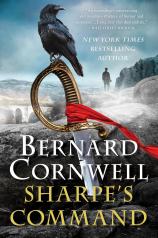Sharpe's Command: Richard Sharpe and the Bridge at Almaraz, May 1812
Review
Sharpe's Command: Richard Sharpe and the Bridge at Almaraz, May 1812
If you read the Richard Sharpe books consistently with their internal chronology, SHARPE’S COMMAND fits in between SHARPE’S COMPANY, which is about the siege of Badajoz, and SHARPE’S SWORD, which revolves around the Salamanca campaign. It is my contention that if you read these three books consecutively (which, of course, you should), you would not be able to tell in any way that two of them were written in the 1980s and the third one came out this year.
Bernard Cornwell has been writing Richard Sharpe novels since 1981, when SHARPE’S EAGLE was published --- and I don’t think that even the most serious reader could tell in what decade any given book in this series was written.
"What makes the Sharpe novels work are the scenes of combat, and Cornwell draws upon all of his considerable talents here."
This is not to say that Richard Sharpe doesn’t grow over the course of the series. He starts out as a hot-headed sergeant in an Indian regiment, fighting against the Mahrattas, and ends up older, wiser and settled in a comfortable retirement in Normandy. The stories take place between 1799 and 1821, concentrating on the European campaign against Napoleon and ending with his death. So it has taken over 40 years for Cornwell to write these tales (including the time he spent penning the excellent Saxon Tales series, about a pagan warrior in early Christian England), and you would expect that over those four decades his approach to writing would have changed in some way.
If that has happened, I don’t know how you’d spot it. The Sharpe novels are nothing if not remarkably consistent. Cornwell continually places Sharpe at the thickest part of the fighting, and he always manages to prevail. Wellington (who appears in many Sharpe books but not in this volume) said of Waterloo that it was “the nearest run thing you ever saw in your life.” That’s a concise description of the key moments in this series.
This time, Sharpe is on a scouting mission in the Spanish countryside, dodging French skirmishers and attempting to work with a ragtag bunch of local guerillas and their flamboyant, cowardly leader. All the familiar elements are in place, so much so that if SHARPE’S COMMAND were a movie, the director would be derided for “fan service.” Yes, Patrick Harper is here to keep Sharpe in line and to fire off the fearsome seven-barreled gun. Yes, Sharpe has to deal with a foppish subordinate wished upon him by the brass (although this particular foppish subordinate, based on an actual officer, turns out to be more than he seems). Yes, there is a full-scale battle in which the courage of one man is enough to tip the scales.
What makes the Sharpe novels work are the scenes of combat, and Cornwell draws upon all of his considerable talents here. The battle in SHARPE’S COMMAND is at a more reduced scale than many of the other stories, with British and Scottish troopers forcing an escapade into an undermanned but well-defended French fort. But what that does is allow Cornwell to tell the story of the smallest part of the battle --- one man scaling the walls with a makeshift ladder who doesn’t even have to be there but knows that men need leaders to follow into the fray.
Reviewed by Curtis Edmonds on April 5, 2024
Sharpe's Command: Richard Sharpe and the Bridge at Almaraz, May 1812
- Publication Date: April 1, 2025
- Genres: Adventure, Fiction, Historical Fiction
- Paperback: 320 pages
- Publisher: Harper Paperbacks
- ISBN-10: 006321931X
- ISBN-13: 9780063219311




